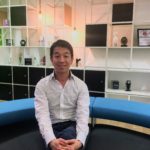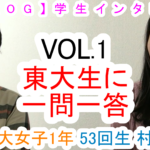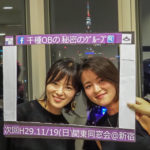OB・OG訪問 vol.2(5回生:井村 亮さん)
OB訪問第2回目は、5回生でサンフランシスコに在住の井村さんを同期4人で訪ねる、という素敵な取材です。
日立で光学系デバイスを研究し、Mu-Chipと呼ばれる非接触デバイスで「IoT」の先駆けとなる開発を手がけて来られた井村さん。
現在リコーの理事を務める傍らカリフォルニア大学バークレー校で教鞭をとり、65歳の今もアクティブに第二の人生を歩まれていらっしゃるようです。
以下、同期の方のコメントです。
「サンフランシスコに在住する同期の井村氏を同期の仲間4人で訪ねました。
5月末に訪れましたが、ちょうどこの時期は井村氏の勤めるUCバークレイもハース•ビジネス•スクールも休みの時期のため、同期5人でサンフランシスコを満喫できました。
現在、多くの様々な国籍の学生と英語で接することができる環境に感謝し、英語力の向上がとても楽しいということでした。
井村氏本人から、『OB訪問』のインタビューに対し、英語でお答えしたいとの希望がありました。」
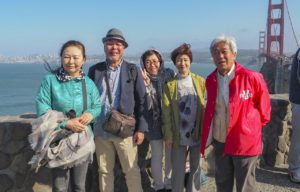
CHIGUSA High School graduates visit
June 8, 2016 RYO IMURA Ph.D
Hello from San Francisco
1. Introduction
Hi, everybody! I am RYO IMURA, an alumnus of the class of 1969, “5 kaisei”, of Chigusa high School. Currently, I am a visiting professor (guest lecturer) at Haas School of Business, University of California, Berkeley, teaching Management of Technology in its MBA program. I am very happy to have this opportunity to be interviewed here in San Francisco where my wife and I have been living since last October.
2. Memories of when I was the CHIGUSA student
Back in 1967, there was no ISSHA Metro station. It was still under construction to expand the Metro line to HUJIGAOKA, so we had to take a bus from HOSHIGAOKA station to commute to CHIKUSA. On rainy days, it was a challenge to walk the slippery and muddy path to the school from the bus stop.
It must be hard to imagine for the current students. At Chigusa, I belonged to the soccer football club and enjoyed playing with my teammates.
My most memorable teacher at CHIGUSA was Hoshino Sensei (his nickname was KUMASAN), my third-grade teacher. Unfortunately, he passed away last year. He taught us Chemistry, not my strongest subject at the time, and I hated his lectures. However, he was such a great teacher that he made it easy for me to understand the subject. Furthermore, he provided me with kind guidance during my high school years. Even after graduation, we maintained a wonderful relationship with both of our families throughout the years, till his passing.
3. How to decide my life plan
My father was a professor at Nagoya University. His field was advanced research in material physics and science using Electron Microscopy to directly observe atomic layer. He was a professor, but was truly a research scientist at heart.
I grew up following his footsteps to become a researcher in academia; however, I found myself more interested in practical and applied research and joined Hitachi Central Research Laboratory in 1977 where I was involved in industry research and development. During my career as a research scientist in industry (1977-2001), I worked in development of Optical Data Storage such as MO & DVD memories as well as Magnetic Recording such as Hard Disc Drive (HDD).
In 2001, I was unexpectedly appointed President& CEO of Hitachi Mu Solutions Company to start up a new business using an innovating technology ‘Mu-Chip’. Mu-Chip is a very tiny semiconductor chip, the size equivalent to a dust particle, embedded into paper media placed in one of the Radio Frequency Identification (RFID) devices. It was a big surprise to me because I only considered myself as an engineering researcher and had no idea or interest in running a business. As some people may know, Mu-Chip was the first innovating RFID successfully used in admission tickets and secure entrance system at Aichi World Exposition in 2005. After this successful implementation, RFID technology has become widely popular in the market to be used in anti-counterfeiting, identification of passport system and food traceability.
I believe that it was the very beginning of the current IoT (Internet of Things) world using a type of sensor networks.
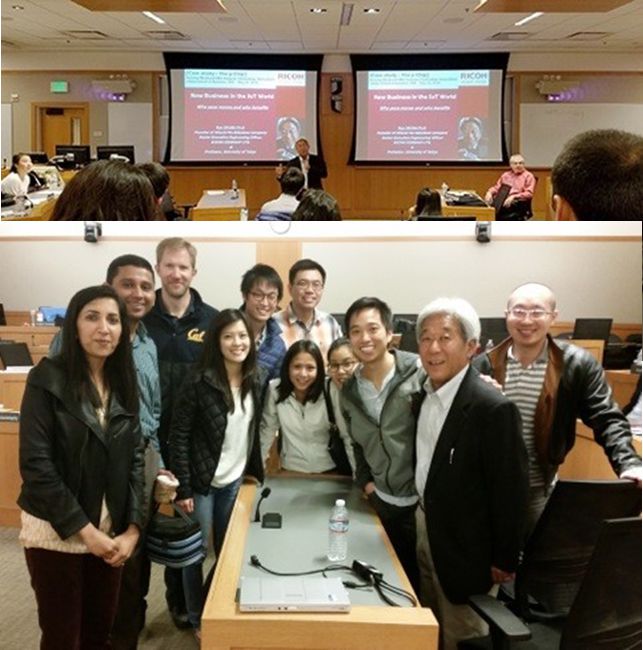
4. My personal topics
Three years ago, I retired from Hitachi, Ltd. and accepted a position at Ricoh Company, Ltd. as an Executive Technology Officer. I still work for Ricoh as one of the Technical Advisory Committee members. Last year, I had a great honor to receive an invitation from University of California, Berkeley to become a visiting professor to teach its MBA students. The reason was that the Mu-Chip start-up formula that I developed was adopted in the teaching materials for the MBA program case study at Haas School of Business in 2003. This was when I decided to move my working base and housing to San Francisco from Tokyo. Most of the students at the MBA program are young entrepreneurs from Silicon Valley. They are very aggressive, enthusiastic and energetic. It is exciting and I always enjoy discussing with them on innovation, leadership, marketing and strategy.
5. My Motto
My interpretation of Charles Darwin’s Theory of Evolution is as follows.
The strongest or the most intelligent may not survive to the end. Rather, those who are capable of responding and adapting to the changes can survive to the end. I love this expression because it applies to people, industries, and even to nations.
6. Favorite pursuit
I love dogs and have always been part of my family members. I miss having a dog with me here in California, but fortunately, I enjoy meeting all types of dogs living in my apartment building. Also, I love cooking. I enjoy creativity in cooking, which I find similarity in research work.
7. Message to the current & future students
50 years ago, there was no modern computer; 20 years ago, there was no internet; and 10 years ago, we had no iPhone. The world we live in is changing dramatically. We live in the world of innovations. What I would like to say here to the young generation is the following. Please be innovative and never hesitate to challenge.
8. Summary
I am no 65 years old and still active, enjoying my second life with my wife here in California. My visiting professor term will end this September and I will return to Japan where I look forward to seeing my Chigusa classmates and students and alumni.
「OB訪問」レポート 5回生 柳川 勤

